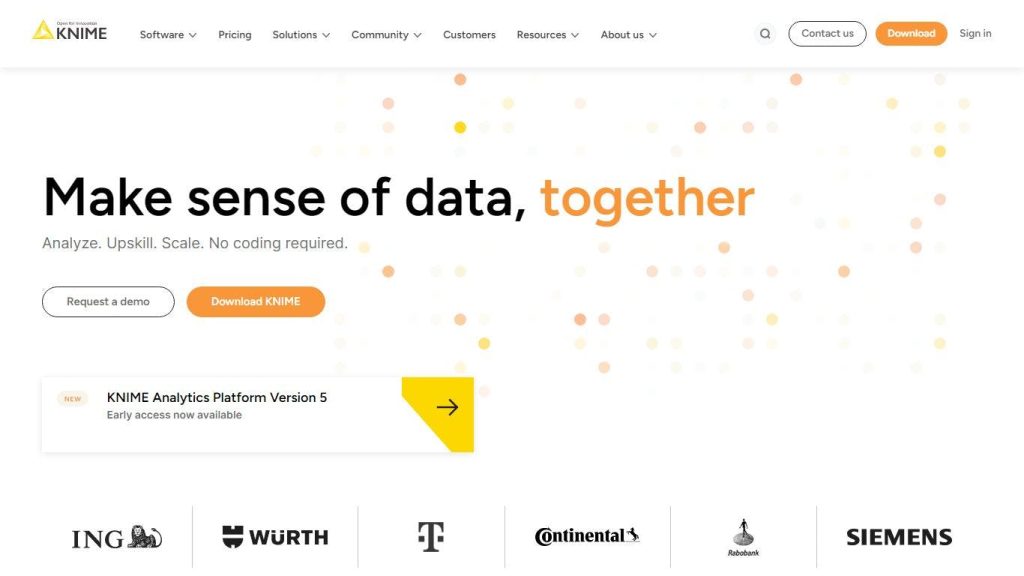What is KNIME?
KNIME, an abbreviation for Konstanz Information Miner, is an open-source data analytics, reporting, and integration platform. By its design, it encompasses all components essential in machine learning and data mining through its modular data pipelining concept. The core functionality is provided by the modules of the platform; using KNIME extensions unlocks more features.
KNIME therefore provides an end-to-end data science solution, from composing analytic models and deploying them to sharing insights within the organization using data apps and services.
Key Features & Benefits of KNIME
The main reasons why KNIME stands out are due to its feature set:
-
Intuitive Visual Interface:
Easy-to-use visual interface for KNIME Analytics Platform to build complex analysis without any coding required. -
Data Integration:
Combine, analyze, and visualize data from multiple sources seamlessly. -
Modular Architecture:
The architecture of the platform is modular; this guarantees scalability and flexibility. -
Free – Open Source – Community Contributions:
KNIME is free, open source, and hence open to contributions from the community at large. -
All-in-One Analytics:
From automation of spreadsheets to machine learning, KNIME serves a wide range of analytical tasks.
With KNIME, there is a list of advantages, including:
-
Ease of use:
User-friendly interface-no need for programming skills, thus in easy reach for a wide audience. -
Teamwork-friendly environment:
KNIME Hub will allow people to collaborate with each other at every level of proficiency. -
Scalability:
From small teams to enterprise-wide projects. -
Cost-effectiveness:
The freemium pricing model provides all the basics for free and allows the user to upgrade upon growing needs.
Use Cases and Applications of KNIME
KNIME has varied applications across industries and sectors:
-
Healthcare:
It is used in patient data analysis to improve treatment plans. -
Finance:
It is used in risk management, fraud detection, and financial forecasting. -
Marketing:
Customer segmentation, Campaign analysis, Sentiment analysis. -
Manufacturing:
Predictive maintenance and quality control are some of the important case studies.
A case in healthcare where a healthcare provider opted to manage all its patient data analysis for better and more personalized treatment plans using KNIME. A financial institution has used KNIME fraud detection in real time, and thereby could reduce fraudulent cases to a great extent.
Usage of KNIME
Getting started with KNIME is easy:
-
Download and Install:
Go to the website, download Analytics Platform from KNIME, and follow the installation wizard to install. -
Getting Familiar with the Interface:
Have a look at nodes, workflows, and views in the graphical user interface. -
Create Your Workflow:
Feel free to create your data pipeline by dragging and dropping. Choose nodes for data input, data processing, and data output. -
Execute and Analyze:
Execute your workflow; analyze it using built-in visualization tools. -
Collaborate:
Publish your workflows into the KNIME Hub to collaborate with colleagues.
Good practice – Some good practice includes frequent saving of your workflow, annotation of your process, and utilizing the community to learn and troubleshoot.
How KNIME Works
At its base, KNIME provides modular data pipelining. Users create workflows by connecting nodes that represent a particular step in processing data, which will in turn eventually bundle up into an integrated data analysis pipeline. KNIME also works with the integration of an array of data sources and most popular data science libraries and tools.
It is realized that the platform uses processing and analytical data from machine learning algorithms and models. The workflow is very orderly or systematic: from data input and pre-processing, transformation, analysis, and finally visualization and output.
Pros and Cons of the use of KNIME
The following are the merits of the use of KNIME:
-
Flexibility of use:
Very modular architecture that allows customization with ease and scalability. -
User-Friendly:
It contains a visual interface suitable for users at different levels of expertise. -
Cost-Effective:
It offers essential features for free with premium features. -
Community Support:
Active community with extensive resource and support.
Cons include:
-
Learning Curve:
Despite the intuitive interface, mastering of the platform can still take some time. -
Resource Intensive:
Big workflows can consume much resource and might need powerful hardware.
User reviews typically give high praise for the adaptability of KNIME and the great set of features but at times note that a minor hurdle is actually the initial learning curve.
KNIME FAQs
-
Q: Is KNIME free to use?
A: Yes, KNIME Analytics Platform is free of charge on its own. The premium options have more advanced features, while enterprise needs are taken care of. -
Q: What type of support does KNIME provide?
-
Q: Does KNIME have a supportive community?
A: Sure. KNIME has a big community with support on forums, tutorials, and example workflows. There is also specific support service for premium users. -
Q: Can I integrate it with other tools?
A: KNIME supports integration with different data sources as well as popular libraries and tools for data science. -
Q: Is KNIME user-friendly for beginners?
A: Certainly. KNIME is graphical and has a lot of resources and is hence usable by users of any level of expertise, even the weakest one. -
Q: How do I share my workflows?
A: You can publish workflows on KNIME Hub, be it in public or private spaces, depending on the use of your workflows.










